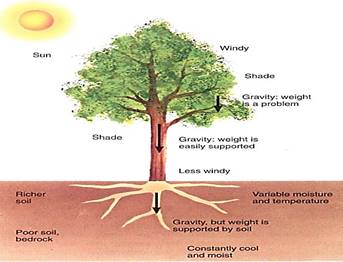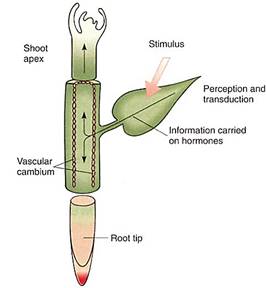


 النبات
النبات
 الحيوان
الحيوان
 الأحياء المجهرية
الأحياء المجهرية
 علم الأمراض
علم الأمراض
 التقانة الإحيائية
التقانة الإحيائية
 التقنية الحيوية المكروبية
التقنية الحيوية المكروبية
 التقنية الحياتية النانوية
التقنية الحياتية النانوية
 علم الأجنة
علم الأجنة
 الأحياء الجزيئي
الأحياء الجزيئي
 علم وظائف الأعضاء
علم وظائف الأعضاء
 الغدد
الغدد
 المضادات الحيوية
المضادات الحيوية|
Read More
Date: 31-10-2016
Date: 20-10-2016
Date: 29-10-2016
|
Introduction to Development and Morphogenesis
If all plants were extremely small and lived in completely uniform, non-varying environments, most would probably be simple and would experience little selective pressure for the evolution of complex shapes, tissues, organs, and metabolism. The most uniform, constant conditions occur in oceans and large lakes, where water buffers rapid changes in temperature, acidity, oxygen concentration, and other factors. Under such stable conditions, small organisms such as algae, protozoans, and sponges are simple. But most organisms exist in a heterogeneous environment: Gravity comes from only one direction; the sun is either to the side or overhead but never below; temperatures are lower on the shady side of a plant; moisture depends on depth below or height above the soil surface. This mosaic of conditions is not stable; it changes over minutes, days, seasons, or longer periods of time. It is selectively advantageous for organisms—plants included—to be able to sense these differences and changes and respond to them.
Most plants are so large that their bodies exist in several different microenvironments. Consider a small tree: Its roots are in soil, which is usually moister, cooler, and darker than air; the highest branches are in open air, exposed to full sunlight and the full force of wind, storms, rain, and snow (Fig. ). The trunk base and lower branches are in an intermediate environment—less stable than soil and less variable and severe than open air. A vertical tree trunk is oriented to best resist gravitational attraction (its own weight), whereas horizontal branches are highly stressed unilaterally by gravity.

FIGURE1: All plants, especially large ones, live in a complex mosaic of microenvironments that differ from each other, often dramatically. Each factor also changes throughout a day or a season.
In springtime, the shoot can become warm enough for active metabolism even though the soil remains cold or frozen. The plant parts must communicate with each other, or shoot buds would become active and expand before roots were capable of transporting water to new leaves. In autumn, decreasing day length and declining air temperatures signal impending winter and the need for dormancy; roots are informed about changing seasons by chemical signals from the shoot. Otherwise, the plant would waste energy constructing a root system larger than necessary.
The need for intercommunication and coordination also exists within a limited region of the body. For example, it is reasonable to hypothesize that leaf parts act in a coordinated fashion during development such that the petiole has enough xylem and phloem to facilitate the transport needs of the blade. Too little conductive tissue causes the blade to suffer water stress or an inability to export sugars to the rest of the plant; too much conductive tissue is a waste of energy and material. Even on the intracellular level, organelles must communicate with each other because their metabolisms are interrelated.
All levels of communication have in common a basic mechanism. Information about the environment or the metabolic status of the organ must be perceived. The plant must sense environmental cues such as changes in temperature, moisture, or day length, or the nucleus must receive chemical signals if conditions in the surrounding cytoplasm change. Next, information must be transduced, or changed to a form that can be either acted upon or transported. Finally, there must be a response: The plant must enter dormancy, produce flowers, change the type of leaf production, and so on (Fig. 2). If any of these steps is missing, the plant cannot respond to the environment. These principles apply to all organisms, and of course higher animals have the most elaborate mechanisms. They have sophisticated sense organs for sight, taste, touch, hearing, and smell that monitor external conditions. Less familiar sensing mechanisms monitor internal, metabolic conditions such as heartbeat, tissue oxygenation, blood pH, and insulin levels. These sensory mechanisms transduce the perceived information to a transportable form such as nerve impulses or hormones that are secreted into the blood stream, making rapid, long-distance integration of the animal possible. Animal responses are also typically highly elaborate, involving precisely controlled movement of muscles and increased activity of organs such as adrenal glands and pancreas and the immune system.

FIGURE 2:The signal for dormancy and preparation for winter is short days in autumn, perceived by leaves. The chemical messenger that is transported from the leaves causes the shoot tip to produce bud scales instead of leaves; the vascular cambium fills with many small vacuoles and stops mitosis and cytokinesis; young xylem mother cells differentiate to a predetermined slopping point, then become dormant; roots slow their growth greatly but usually do not stop completely. Roots and the cambial region cannot perceive the approach of winter themselves but depend on leaves as sites of perception. Although the shoot apices could perceive it themselves, the entire plant is integrated as a whole by being cued by the leaves.
Sensory systems and response mechanisms of plants tend to be simpler than those of animals, and the signal transport is usually slow, involving movement through cortex parenchyma or phloem. This does not mean that animal systems are superior to those of plants. "Superior" has no meaning: The proper question is, "Which is more adaptive, which is more advantageous selectively?" In terms of evolution and natural selection, animal systems are successful adaptations for organisms that must detect food or predators and must move in order to capture that food or avoid being captured. Any animal with a plant-type mechanism of perception, transduction, and response would soon starve or be eaten Perception of and response to mates for sexual reproduction also require sensitive, rapid response mechanisms.
On the other hand, rapid response mechanisms would not be adaptive in plants: They are extremely expensive to build and maintain and are unnecessary because most conditions important to plants change only slowly. Eyes, nerves, muscles, or adrenal glands are not needed by plants lor the absorption of carbon dioxide, water, minerals, or light or for perception of autumn and preparation for winter dormancy. For sexual reproduction, animal-pollinated plants do need sophisticated perception and response mechanisms, but basically, they simply "rent" those of their pollinators, paying with nectar or other rewards. Finally, the very sophistication of animal sensory/response systems makes animals more vulnerable, more easily injured, and more dependent on avoiding dangers such as fires, floods, freezes, and predators. Plants are typically much more resilient than animals, being able to survive burning because of thick bark or resprouting from rhizomes and bulbs; many withstand flood by being tough or flexible. Predators can consume most of a plant's leaves, wood, or roots without actually killing the plant.



|
|
|
|
مخاطر عدم علاج ارتفاع ضغط الدم
|
|
|
|
|
|
|
اختراق جديد في علاج سرطان البروستات العدواني
|
|
|
|
|
|
|
مدرسة دار العلم.. صرح علميّ متميز في كربلاء لنشر علوم أهل البيت (عليهم السلام)
|
|
|